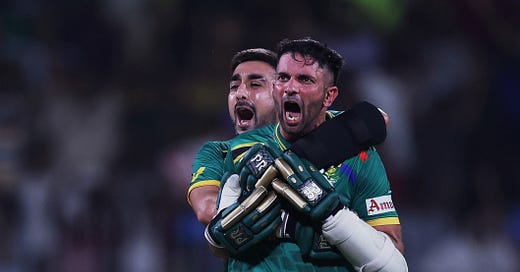Keshav Maharaj thought he was there to carry drinks and learn. That is what he told Vernon Philander when the pacer tapped him on the shoulder and asked him if he was ready. The next morning, Maharaj received his Test cap from Hashim Amla. Cap number 92.
When Faf du Plessis threw him the ball in the 19th over after Dale Steyn had hurt his shoulder, Maharaj’s first thought was that his job was to hold up an end while the seamers took the wickets around him. Again, he was wrong. He took three wickets for 56 runs in 18.2 overs in the first innings.
“I didn’t know what to do with the first ball, but something on my shoulder told me ‘you belong here,’” says Maharaj as he relives the memory.
When he walked out to bat after 40.3 overs, South Africa was in trouble. They were on 250/7 chasing 271 to win. Only Maharaj, Gerald Coetzee, Lungi Ngidi and Tabraiz Shamsi between Pakistan and a third World Cup victory. Pakistan had Shaheen Afridi, Mohammad Wasim and Haris Rauf still to bowl out their 10-over allocations.
Coming into the match, Afridi had taken 18 wickets from 11 innings in the overs between 41 and 50 at an average of 11 and an economy of 6.46 in 2023. In the same period, Rauf took 11 wickets from 11 innings at an average of 15.73 and an economy of 6.53, while Wasim had three wickets in six death innings at an average of 25.67 and an economy of 5.63.
In contrast, Maharaj averaged 14.33 in five, while Coetzee averaged 7 runs in five innings, Ngidi averaged 25 in six and Shamsi had scored one run in three innings for an average of 0.33 at a strike rate of 7.69. The odds were in favour of Pakistan and their seamers.
This newsletter is completely reader-supported. If you’re willing and able, please consider supporting it in one of two ways, leaving a tip or becoming a Patreon. Thank you so much for your time and investment!
The same voice on his shoulder that gave him confidence on his Test debut gave him confidence against Pakistan’s world-class seamers. After all, Maharaj isn’t as hopeless with the bat as his numbers suggest. After Kiran More looked into Maharaj’s palms and declared that the ten-three-year-old would be a professional cricketer, Ahtmanand Maharaj set about teaching his son all he knew about the game. Ahtmanand was a wicketkeeper-batter during his time. Day after day, he fed his son throwdowns and taught him the correct batting technique.
As a youngster, he was a decent enough batter to bat in the top six. When he turned out for Cuckfield Cricket Club in 2013, Maharaj showed up with both bat and ball. On the night that Linda Zondi called Maharaj to tell him he had been selected for the Proteas’ tour to Australia, Maharaj had scored a blistering 71-ball 72 for the Dolphins in a four-day match. In 2018, as part of his preparation for South Africa’s tour to Sri Lanka, Maharaj flew to Bangalore to work on his bowling and batting with Prasanna Agoram.
“He told me that he did not just want to be the best spinner, he wanted to contribute with the bat as well, and possibly develop into an allrounder,” said Prasanna when we talked about the time Maharaj was with him in India. In 2023, the one enduring memory from that tour is riding on a moped with Prasanna at the wheel. “I will never ride on a moped with PDogg again,” says Maharaj.
The work he puts into his batting doesn’t always translate to runs on the field. But, that doesn’t slow him down. Maharaj is a believer in the process. “Keshav is one of the hardest-working players on the circuit. He has always believed that he has the ability with the bat & decided to put in extra work on his batting as he knows he has always had the potential. So before training, he would come in earlier just to hit balls,” says Duzi Mbata, Maharaj’s batting coach at the Dolphins.
Maharaj’s natural impulse is to attack the bowlers. At training, he focuses on doing the basics well and grooving his technique, but his favourite shot is going over the top straight. More often than not, he falls going for the big shot. Maharaj comes out swinging. Most times, he is there for a good time and not a long time.
Against Pakistan, he adopted the ‘slowly, slowly’ approach. Maharaj scored his first run off the seventh delivery he faced. He faced another seven for his second run. After facing 19 deliveries, Maharaj had three runs to his name. Then on the 21st ball he faced, he scored the winning runs off Mohammad Nawaz, who lobbed the ball onto Maharaj’s pads. Maharaj helped it behind square on the leg side.
It was probably the slowest seven runs Maharaj has scored in one-day cricket, but like Shamsi’s four runs off six deliveries, they were some of the most important runs either batter has scored in 50-over cricket. They drew South Africa closer to a semi-final spot. And they shattered the World Cup dreams of more than 200 million Pakistan fans.
If you found this interesting, please share it:
You can support Stumped! by leaving a tip:
Thanks for reading. Until next time… - CS






